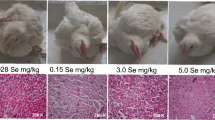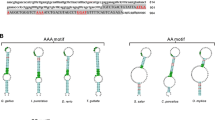Abstract
As selenium in the form of “Selenoprotein W (SelW)” is essential for the maintenance of normal liver function, the expression of SelW liver depends on the level of selenium supplied with the diet. Whereas this is well known to be the case in mammals, relatively little is known about the effect of dietary Se on the expression SelW in the livers of avian species. To investigate the effects of dietary Se levels on the SelW mRNA expression in the liver of bird, 1-day-old male chickens were fed either a commercial diet or a Se-supplemented diet containing 1.0, 2.0, 3.0, and 5.0 mg/kg sodium selenite (Na2SeO3) for 90 days. The livers were collected and examined for Se content and mRNA levels of SelW, Selenophosphate synthetase-1, and selenocysteine-synthase (SecS). The data indicate that, within a certain range, a Se-supplemented diet can increase the expression of SelW and the mRNA levels of SecS, and also, that the transcription of SelW is very sensitive to dietary Se.




Similar content being viewed by others
References
Behne D, Kyriakopoulos A (2001) Mammalian selenium-containing proteins. Annu Rev Nutr 21:453–473
Driscoll DM, Copeland PR (2003) Mechanism and regulation of selenoprotein synthesis. Annu Rev Nutr 23:17–40
Hatfield DL, Carlson BA, Xu XM et al (2006) Selenocysteine incorporation machinery and the role of selenoproteins in development and health. Prog Nucleic Acid Res Mol Biol 81:97–142
Leinfelder W, Stadtman TC, Bock A (1989) Occurrence in vivo of selenocysteyl-tRNA(SERUCA) in Escherichia coli: effect of sel mutations. J Biol Chem 264:9720–9723
Lee BJ, Worland PJ, Davis JN et al (1989) Identification of a selenocysteyl-tRNA(Ser) in mammalian cells that recognizes the nonsense codon, UGA. J Biol Chem 264:9724–9727
Vendeland SC, Beilstein MA, Chen CL et al (1993) Purification and properties of selenoprotein W from rat muscle. J Biol Chem 268:17103–17107
Loflin J, Lopez N, Whanger PD et al (2006) Selenoprote in W during development and oxidative stress. J Inorg Biochem 100:1679–1684
Clark LC, Combs GF Jr, Turnbull BW et al (1996) Effects of selenium supplementation for cancer prevention in patients with carcinoma of the skin. A randomized controlled trial. Nutritional Prevention of Cancer Study Group. JAMA 276:1957–1963
Whanger PD (2000) Selenoprotein W: a review. Cell Mol Life Sci 57:1846–1852
Guimaraes MJ, Peterson D, Vicari A et al (1996) Identification of a novel selD homolog from eukaryotes, bacteria, and archaea: is there an autoregulatory mechanism in selenocysteine metabolism? Proc Natl Acad Sci USA 93:15086–15091
Kim IY, Guimaraes MJ, Zlotnik A et al (1997) Fetal mouse selenophosphate synthetase 2 (SPS2): characterization of the cysteine mutant form overproduced in a baculovirus-insect cell system. Proc Natl Acad Sci USA 94:418–421
Kim IY, Stadtman TC (1995) Selenophosphate synthetase: detection in extracts of rat tissues by immunoblot assay and partial purification of the enzyme from the archaean Methanococcus vannielii. Proc Natl Acad Sci USA 92:7710–7713
Low SC, Harney JW, Berry MJ (1995) Cloning and functional characterization of human selenophosphate synthetase, an essential component of selenoprotein synthesis. J Biol Chem 270:21659–21664
Tamura T, Yamamoto S, Takahata M et al (2004) Selenophosphate synthetase genes from lung adenocarcinoma cells: Sps1 for recycling L-selenocysteine and Sps2 for selenite assimilation. Proc Natl Acad Sci USA 101:16162–16167
Small-Howard A, Morozova N, Stoytcheva Z et al (2006) Supramolecular complexes mediate selenocysteine incorporation in vivo. Mol Cell Biol 26:2337–2346
Leinfelder W, Zehelein E, Mandrand-Berthelot M et al (1988) Gene for a novel tRNA species that accepts L-serine and cotranslationally inserts selenocysteine. Nature 331:723–725
Hendrickson TL (2007) Easing selenocysteine into proteins. Nat Struct Mol Biol 14:100–101
Burk RF, Hill KE (2005) Selenoprotein P: an extracellular protein with unique physical characteristics and a role in selenium homeostasis. Annu Rev Nutr 25:215–235
Hasunuma R, Ogawa T, Kawanishi Y (1982) Fluorometric determination of selenium in nanogram amounts in biological materials using 2, 3-diaminonaphthalene. Anal Biochem 126:242–245
Peirson SN, Butler JN, Foster RG (2003) Experimental validation of novel and conventional approaches to quantitative real-time PCR data analysis. Nucleic Acids Res 31:e73
Pfaffl MW (2001) A new mathematical model for relative quantification in real-time RT-PCR. Nucleic Acids Res 29:e45
Li JL, Ruan HF, Li HX et al (2010) Molecular cloning, characterization and mRNA expression analysis of a novel selenoprotein: avian selenoprotein W from chicken. Mol Biol Rep (in press)
Yeh JY, Gu QP, Beilstein MA et al (1997) Selenium influences tissue levels of selenoprotein W in sheep. J Nutr 127:394–402
Yeh JY, Vendeland SC, Gu Q et al (1997) Dietary selenium increases selenoprotein W levels in rat tissues. J Nutr 127:2165–2172
Sun Y, Ha PC, Butler JA et al (1998) Effect of dietary selenium on selenoprotein W and glutathione peroxidase in 28 tissues of the rat. J Nutr Biochem 9:23–27
Yeh JY, Beilstein MA, Andrews JS et al (1995) Tissue distribution and influence of selenium status on levels of selenoprotein W. FASEB J 9:392–396
Vendeland SC, Beilstein MA, Yeh JY et al (1995) Rat skeletal muscle selenoprotein W: cDNA clone and mRNA modulation by dietary selenium. Proc Natl Acad Sci USA 92:8749–8753
Gu QP, Beilstein MA, Barofsky E et al (1999) Purification, characterization, and glutathione binding to selenoprotein W from monkey muscle. Arch Biochem Biophys 361:25–33
Gu QP, Sun Y, Ream LW et al (2000) Selenoprotein W accumulates primarily in primate skeletal muscle, heart, brain and tongue. Mol Cell Biochem 204:49–56
Zhou JC, Zhao H, Li JG et al (2009) Selenoprotein gene expression in thyroid and pituitary of young pigs is not affected by dietary selenium deficiency or excess. J Nutr 139:1061–1066
Wang H, Wei W, Zhang SY et al (2005) Melatonin–selenium nanoparticles inhibit oxidative stress and protect against hepatic injury induced by Bacillus Calmette–Guerin/lipopolysaccharide in mice. J Pineal Res 39:156–163
Wu Q, Huang K (2004) Effect of long-term Se deficiency on the antioxidant capacities of rat vascular tissue. Biol Trace Elem Res 98:73–84
Thirunavukkarasu C, Sakthisekaran D (2003) Sodium selenite, dietary micronutrient, prevents the lymphocyte DNA damage induced by N-nitrosodiethylamine and Phenobarbital promoted experimental hepatocarcinogenesis. J Cell Biochem 88:578–588
Yu SY, Zhu YJ, Li WG (1997) Protective role of selenium against hepatitis B virus and primary liver cancer in Qidong. Biol Trace Elem Res 56:117–124
Brigelius-Flohe R, Banning A (2006) Part of the series:from dietary antioxidants to regulators in cellular signaling and gene regulation. Sulforaphane and selenium, partners in adaptive response and prevention of cancer. Free Radic Res 40:775–787
Xu XM, Carlson BA, Irons R et al (2007) Selenophosphate synthetase 2 is essential for selenoprotein biosynthesis. Biochem J 404:115–120
Acknowledgments
This study was supported by the National Natural Science Foundation of China (30871902) and Science and Technology Research Foundation of Heilongjiang Provincial Education Department (11551030).
Author information
Authors and Affiliations
Corresponding author
Rights and permissions
About this article
Cite this article
Sun, B., Wang, R., Li, J. et al. Dietary Selenium Affects Selenoprotein W Gene Expression in the Liver of Chicken. Biol Trace Elem Res 143, 1516–1523 (2011). https://doi.org/10.1007/s12011-011-8995-z
Received:
Accepted:
Published:
Issue Date:
DOI: https://doi.org/10.1007/s12011-011-8995-z




